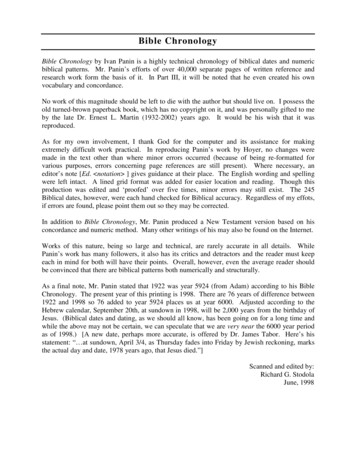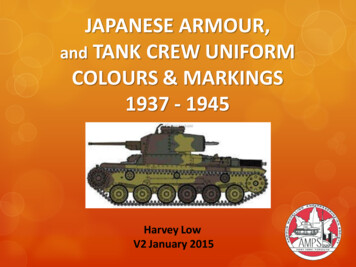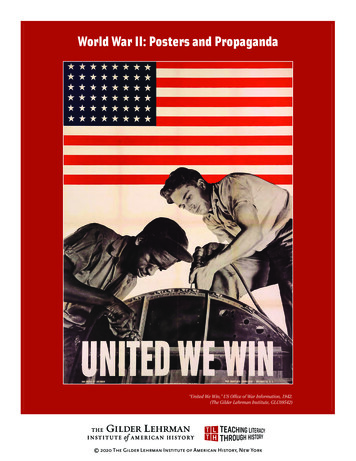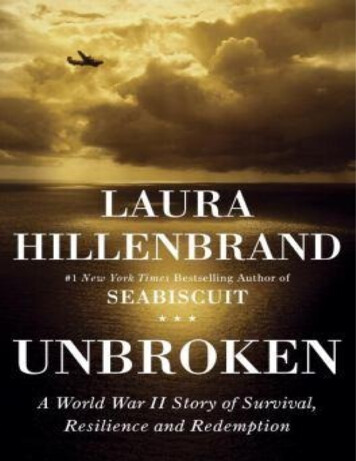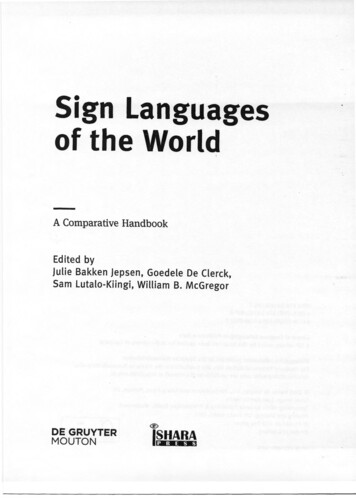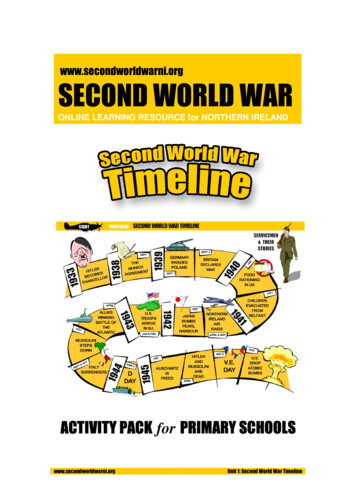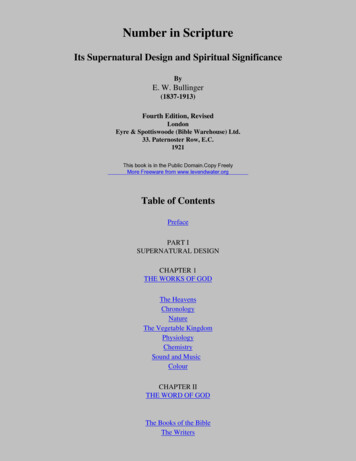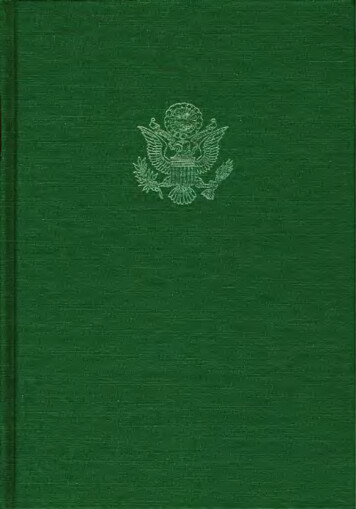
Transcription
ForewordThe relationship o f events in lime is the essence of history. Chronology: 194/-1945establishes the sequence of evenls from the lime the firs t bombs on Pearl Harbor on 7December 194 1 until the instrument of surrender was signed aboard the USS Missouri inTokyo Bay on 2 Septe mber 1945. T he other volumes in the series United States Army inWorld War II recounl in detail the various asp eCts of a complex global war-individualcampaigns. grand strategy, logis tics, support. and so forth . In this volume the reader can seethe events of the war d ay by d ay in their sequence and cont emporaneity, measure the scope ofthe global struggle. and begin to gr sp the relation of the innumerable p arts to the who le.Washington , D.C .23 June 1958R . W . STEP H ENSMaj. Gen., U .S.A .Chirj of Military History
PrefaceThe chronology is primarily one of tactical events of World War II from the timethe United States was drawn into the conRict on 7 December 1941 until the surrenderof Japan in 1945, with emphasis on ground action by United States arrn.ed forces. Airand naval co-operation, combat actions of foreign units-both Allied and enemy-and general events of world-wide interest arc detailed within the scope of space limitations.Geographically, events for the period from Pearl Harbor to the invasion of Normandyon 6 June 1944 arc arranged in sequence from the Western Hemisphere westward aroundthe world. From D Day to the end of the war the order is reversed. the action in westernEurope taking precedence. The dates used are thbse of the area under d iscussion. Thus,the attack on Pearl Harbor is dated 7 December while the events occurring simultaneouslyin the Far East appear under 8 December. An exception has been made for the Gilbertsand 'Marshalls campaign because the scene of engagement lies so near the lnternationalDate Line and also because most of the records consulted are dated west longitude.To itemize the materials used in the preparation of this work of reference would betedious, if not impossible. Suffice it to say that the compiler consulted extensively AfterAction Reports, histories of units engaged, dispatches of the Allied commanders, and otherprimal)' sources, but for correctnes ; and completeness relied heavily on the findings of thehistorians who have written and are writing other volumes for the UNITED STATESARMY IN WORLD WAR II, on the Hislory 0/ United Stales Na val Operations in WorldWar JJ by Samuel Eliot Morison, and on The Army Air Forces in World War 1I editedby Wesley Frank C raven and James Lea Cate.The volume is the product of a co-operative effort of the Chronology Section- firstof the Historical Division and then of the Office of the Chief of Military History. Toone staff member, Miss Goldie Ann Kannmacher, the compiler is especially grateful forunstinting service throughout most of the life of the project. The assistance of Miss BettyLet Belt in the project's initial stages is gratefully acknowledged. For directing the workof the staff during a six-month absence of the compiler, acknowledgments are due Maj.John M. Balcer. Members of the staff who served it ably are Mrs. Margaret Letnhouts,Miss Mary G. Schuster, Miss Ruth Upson, Miss Grace Waibel, Miss Elizabeth Stribling, andthe late Mrs. Priscilla White. Miss Lauretta Plockelman and Miss Jaqueline Van H ovelcontributed valuable clerical assistance.The compiler is also grateful to Dr. Kent Roberts Greenfield for his advice and moralsupport. To Miss Mary Ann Bacon, who edited the volume, to Nicholas 1- Anthony forthe Index, and to Mr. Israel Wice, Chief, General Reference Office, and his competentassistants. who acquired the materials used, I acknowledge my great indebtedness.Washington, D.C.21 February 1958MARY H. WILLIAMS
[1]CHRONOLOGY1941–1945
[2]
[3]19417 DecemberI NTERNATIONAL S ITUATION —Japan strikes without warning and almost simultaneously at variousU.S. and British possessions in the Pacific; declareswar against U.S. and Great Britain.H AWAII —Launched from carriers of a navaltask force (TF) standing 200 miles N of Oahu,Japanese planes attack Oahu between 0750 and 1000bombing the Pacific Fleet, which, except for thecarriers, is concentrated in Pearl Harbor, and AAFplanes parked in close formation on Hickam andWheeler airfields. 3 BB's are sunk, another is capsized, and 4 more are damaged; 3 CL's, 3 DD's, andother vessels are seriously damaged. 92 Navy and96 Army planes are lost. American casualties are2,280 killed and 1,109 wounded. Japanese lose 29planes and 5 midget submarines.M IDWAY —At 2135, 2 Japanese DD's bombardMidway, garrisoned by a small U.S. Marine detachment (6th Defense Bn), to neutralize it.L IBYA —Maj Gen N. M. Ritchie's British (Br)Eighth Army, a component of Gen Sir Claude J. E.Auchinleck's Br Middle East Forces (MEF), continues offensive, begun in November, to clear Libyaof German and Italian forces, which are nominallyunder Italian command, but actually under GermanField Marshal Erwin Rommel. Objective is twofold: first, destruction of enemy concentrated in ECyrenaica, which is in progress; second, conquest ofTripolitania. Armd elements of Br 30 Corps battle enemy tanks around Bir el Gubi. After nightfall, Br 13 Corps goes on the offensive, 10th Divdriving along El Adem Ridge, key feature S ofTobruk.USSR—German offensive (Operation BARBAROSSA, begun on 22 July 1941 by Field MarshalWalther von Brauchitsch, CinC of the GermanArmy) to crush Soviet forces has ground to a halt onbroken line from Lake Ladoga on N to Sea of Azovon S. At the extremities of front, Soviet garrisons ofLeningrad and Sevastopol are besieged; on centralfront Germans are at outskirts of Moscow. RedArmy is conducting general counteroffensive (begun on 6 December) to drive enemy westward. 3fresh Soviet armies are exerting pressure againstenemy spearheads in vicinity of Moscow. Althoughassured the support of satellite nations (Finland,Rumania, Hungary), Germans are at a disadvantagebecause of overextended supply lines and battleexhaustion.W ESTERN E UROPE —Although Adolf Hitler hasby this time abandoned plans for invasion of England (Operation SEA LION) as result of defeat ofLuftwaffe in Battle of Britain (8 August–31 October1940), German planes continue active over England.RAF in turn has been making frequent attacks onEuropean continent.8 DecemberI N T E R N AT I O N A L S I T UAT I O N —U.S. and GreatBritain declare war on Japan. On W side of international date line (7 December, Hawaiian time),Japanese bombard Wake and Guam, each garrisoned by small detachments of U.S. marines;British-mandated Nauru and Ocean Islands; thePhilippines; British Malaya and Singapore; Thailand; Hong Kong.P.I.—Japanese naval planes from Formosa attack Clark and Iba Fields and catch many aircraft onthe ground. FEAF is reduced to almost halfstrength, and installations are severely damaged.Tuguegarao and Baguio are each hit by JapaneseArmy planes before the main strike against ClarkField. TF 5, Asiatic Fleet, under Rear Adm William A. Glassford, heads S toward safer waters.Japanese begin advance landings to acquire air basesfrom which to support main assault: invade BatanI., between Formosa and Luzon, without opposition.T HAILAND —Some Japanese from Indochinacross into Thailand and drive on Bangkok againstnegligible resistance. Others land unopposed atSingora and Patani on E coast and start SW acrossKra Isthmus to assist in conquest of Malaya.MALAYA—Japanese invade Malaya early in themorning, landing on E coast near Kota Bharu afternaval bombardment of beaches, and are vigorouslyengaged by Lt Gen A. E. Percival's Malaya Command. Ind 3 Corps (under Lt Gen Sir LewisHeath), which is responsible for all Malaya N ofJohore and Malacca, employs Ind 9th Div againstenemy in Kota Bharu area and sends Ind 11th Div,already poised to move into Thailand, across borderto delay enemy on roads to Singora and Patani. Ind9th Div, whose primary mission is to protect the 3airfields in Kelantan (Kota Bharu, Gong Kedah,
[ 9–11 DECEMBER 1941 ][4]and Machang), fights losing battle for Kota Bharu,from which it starts withdrawing during night 8–9.One Ind 11th Div column, driving toward Singora,engages tank-supported enemy force 10 miles N offrontier; another, advancing toward Patani, is opposed only by Thai police forces. In conjunction withground attacks, Japanese planes strike repeatedly atairfields in N Malaya and greatly reduce strengthof RAF Far East Command. RAF, after attackingenemy shipping and troops in Kota Bharu area,withdraws from the Kelantan airfields to Kuantan,far to S. Singapore, ultimate objective of Japanese25th Army in Malaya, is also attacked by air.CHINA—Japanese seize International Settlementat Shanghai, and many ships are sunk or captured inits harbor; move troops toward Kowloon, on mainland across from Hong Kong.L IBYA —Axis forces begin orderly withdrawaltoward Gazala, followed closely by 13 and 30 Corpsof Br Eighth Army and harassed by RAF. Skillfulrear-guard action delays pursuit.USSR—German Army Group North withdrawsfrom Tichwin, on Leningrad-Vologda RR, underSoviet pressure. Army Group Center is slowly givingground in Moscow area.9 DecemberC ENTRAL P ACIFIC —Japanese continue preinvasion bombing of Wake and Guam; invade GilbertIs.P.I.—Continuing neutralization of airpower onLuzon, enemy bombers strike Nichols Field, nearManila.T HAILAND —Japanese occupy Bangkok withoutopposition.M ALAYA —Japanese force Ind 9th Div of Ind 3Corps from Kota Bharu airfield and continue airattacks on other fields, including Kuantan. RAFabandons Kuantan airfield for Singapore I. and AlorStar airfield, on NW coast, for Butterworth. RAFbomber attack on Singora airfield (Thailand) provesvery costly since fighter protection is lacking. Dutchplanes arrive at Singapore to augment strength ofRAF.C HINA —Declares war on Japan, Germany, andItaly.10 DecemberC ENTRAL P ACIFIC —Japanese invade Guam andoverwhelm small U.S. garrison; continue preinvasion bombing of Wake.P.I.—Two Japanese TF's, each consisting ofsome 2,000 men, arrive off N Luzon from Formosa.Landings begin simultaneously at Aparri and nearVigan, but rough sea forces alteration in plans. TheAparri force gets 2 cos ashore at Aparri and the restat Gonzaga, over 20 miles to E; upon closing onAparri, pushes 6 miles S and seizes Camalaniuganairstrip. The Vigan force lands small group at Pandan, near Vigan, and the rest at point 4 miles S;quickly secures Vigan and sends elements N alongRoute 3 toward Laoag. No opposition is offered by11th Div (PA), which is responsible for defense of Ncoast. U.S. planes attack shipping of the invasionforce. Capt Colin Kelly becomes the first U.S. heroof World War II in this action by hitting what wassupposed to be a Japanese BB; subsequent investigation has revealed that there were no BB's present.Fighter aircraft from Batan I. provide cover forenemy. Japanese planes bomb and strafe Nichols andNielson Fields, near Manila, and Del Carmen Field,near Clark, achieving particularly damaging resultsat Nichols. Cavite naval base also suffers heavilyfrom enemy air attack. FEAF, by this time halfstrength, decides to confine its future activities to rcnflights.M ALAYA —Japanese gain control of waters E ofMalaya and air over N Malaya. The small BritishEastern Fleet is severely crippled by loss of Repulseand Prince of Wales off Kuantan to enemy planes.Adm Sir Tom Phillips, CinC Eastern Fleet, is killedin this action and is replaced by Vice Adm SirGeoffrey Layton. As enemy continues destructiveattacks on airfields in NW Malaya, RAF abandonsairfield at Sungei Patani and withdraws all serviceable aircraft from Butterworth. From Butterworth,RAF bomber sq, reduced to 2 aircraft, withdraws toTaiping and RAAF fighter sq (6 repairable aircraft) to Ipoh. Japanese begin series of heavy airattacks against Penang I. Ind 9th Div withstandsattacks while organizing delaying positions S ofKota Bharu. Ind 11th Div columns operating alongThailand frontier attempt to delay enemy. Far EastCouncil is formed at Singapore.L IBYA —Siege of Tobruk is lifted after 8 monthsas Pol garrison breaks out of town early in morning and joins other Br Eighth Army forces inAcroma area. Forward supply base is soon organizedat Tobruk.11 DecemberI NTERNATIONAL S ITUATION —Germany and Italydeclare war on U.S., which then replies withdeclarations against them.W AKE —Wake garrison (about 450 marines of1st Defense Bn) repels invasion attempt. Japanesenaval force arrives off Wake early in morning andat dawn opens fire. Shore batteries force the vesselsto withdraw with landing force still embarked.4 aircraft of VMF–211, all that remain serviceableof the original fighter sq on Wake, pursue and attack enemy force as it retires toward the Marshalls.2 planes that survive this action intercept shore-based
[ 12–13 DECEMBER 1941 ]Japanese aircraft that try to attack Wake later in themorning. Wake is subsequently subjected to almostdaily air strikes as enemy continues softening thedefense in preparation for landing.P.I.—Japanese Aparri force on Luzon continuesrapidly S along Route 5 toward Tuguegarao.Laoag and its airfield fall to Vigan force. Japanesebegin mining San Bernardino and Surigao Straits.Commercial vessels withdraw from Manila Bay.M ALAYA —Ind 9th Div, Ind 3 Corps, abandonsthe 2 remaining airfields in Kelantan (Gong Kedahand Machang) in order to protect communications.Japanese exert strong pressure against one Ind 11thDiv column on Kroh-Patani road and force theother, on road to Singora, back toward partiallyprepared positions at Jitra. RAF, now greatly depleted in strength, adopts policy of conductingbomber operations only at night until adequatefighter support is available and of using fightersprimarily for defense of Singapore Naval Base andfor protection of convoys bringing reinforcements.Ind 3 Corps troops are thus denied much close airsupport.B URMA —Japanese begin offensive against lowerBurma with air attack on Tavoy airdrome.12 DecemberP ACIFIC —U.S. troops aboard Allied convoy proceeding from Hawaii toward Far East under escortof CA Pensacola are organized as TF South Pacificand placed under command of Brig Gen Julian F.Barnes.P.I.—Japanese make another preliminary landing, at Legaspi, S Luzon. TF of 2,500 men fromPalau goes ashore unopposed and secures Legaspiand the airfield. Maj Gen George M. Parker, Jr.,whose South Luzon Force consists of 41st and 51stDivs (PA), sends elements of 51st forward to delayenemy, but contact is not made for several days.Tuguegarao airfield falls to Aparri force early inmorning. Japanese planes attack Luzon in force.Iba and Clark Fields are targets, with main forceagainst Iba. Batangas is an alternate target.M ALAYA —Gen Percival decides to withdrawInd 3 Corps from Kelantan since airfields there arealready in possession of Japanese; movement of surplus supplies to rear is begun. Troops fight delayingactions while awaiting rolling stock in which towithdraw. Japanese penetrate Jitra position and forceInd 11th Div TF back to Kedah R. Ind 11th Divforce, called Krohcol force, on Kroh–Patani road,also falls back under pressure and at midnight 12–13passes to direct command of corps. Ind 12th BrigGp is released from reserve for action on W coast.B URMA —Japanese begin small-scale operations,using infiltration tactics. From Thailand, small force[5]crosses into lower Tenasserim unopposed. Gen SirArchibald P. Wavell, CinC India, is given responsibility for Burma, previously within Air Chief Marshal Sir Robert Brooke-Popham's Far Eastern Command, and is promised reinforcements to strengthenthe small garrison, fighting strength of which doesnot exceed 30 bns during the campaign. Lt GenD. K. MacLeod's Burma Army, charged with protecting Burma Road and Tenasserim airfields, is aheterogeneous group of Burmese, Ind, and Br forces,some poorly trained, formed into Burma 1st Div(Burma 1st and 2d Brigs and Ind 13th Brig) andInd 16th Brig. The 16 obsolete RAF fighters onhand are augmented by sq of American VolunteerGroup (AVG) fighters, which is f lown in to Mingaladon from AVG base in China. Air strength iseventually increased but not enough to alter groundoperations materially.MIDDLE EAST—Gen Auchinleck receives the firstof a number of notices that forces intended forMiddle East must be diverted to Far East to helpstem Japanese advance. First call is for Br 18th andInd 17th Divs, 4 light bomber sqs, and AA and ATguns.L I BYA —Eighth Army's 30 Cor ps moves toLibyan-Egyptian frontier to destroy isolated enemygarrisons and open communication lines. 13 Corpsbegins probing enemy's new line, which extendsfrom Gazala southward.13 DecemberP.I.—Enemy aircraf t again att ack Luzon,virtually completing destruction of U.S. Army andNavy planes in the Philippines. Del Carmen, Clark,and Nichols Fields are hit, as well as Baguio, Tarlac,Cabanatuan, and Batangas.M ALAYA —Krohcol force concentrates in positions 2–3 miles W of Kroh. Ind 11th Div beginswithdrawing from Kedah R toward Gurun, a morefavorable defense position in S Kedah some 30 milesS of Jitra. Fighter support is increased as sq fromSingapore joins the few fighters based at Ipoh. Reports of Japanese convoy moving SSW from Saigonresult in period of sharply increased Br air rcn fromMalaya.B ORNEO —Small Miri detachment (Ind co andengineers), having destroyed oil fields and installations in E Sarawak and W Brunei to deny them toenemy, sails for Kuching, capital of Sarawak, whererest of the Ind bn, with local and administrativeattachments, is disposed to defend airdrome. Dutchplanes based on Singkawang assist RAF units onMalaya in searching for Japanese shipping headingsouthward from Indochina.C HINA —British withdraw from Kowloon underpressure as Japanese continue drive on Hong Kong.
[ 14–17 DECEMBER 1941 ][6]B URMA —Victoria Pt, at S tip of Tenasserim, isevacuated by British.L IBYA—13 Corps, Br Eighth Army, opens attackon Rommel's Gazala line and meets firm resistance.Both sides suffer heavy losses.14 DecemberP.I.—Japanese Vigan and Aparri detachmentsare placed under the same command and ordered,after the Aparri force joins the Vigan at Vigan, tomarch S to Lingayen Gulf. Adm Thomas C. Hartwithdraws the few remaining patrol bombers ofPatrol Wing 10 and 3 tenders from the Philippines,leaving very little of the Asiatic Fleet to supportoperations. Maj Gen Lewis H. Brereton has alreadywithdrawn the heavy bombers of FEAF from Luzonto Del Monte airfield, Mindanao.M ALAYA —On W coast, Ind 11th Div completeswithdrawal to Gurun; Japanese, in close pursuit,penetrate the new positions, night 14–15. Krohcolforce is dissolved and its components, which areput under command of Ind 12th Brig, move toBaling area, about 9 miles W of Kroh. Ind 3 Corpssends small detachments to guard Grik road, whichis now uncovered. On E coast, Kelantan force continues fighting withdrawal. Since airdromes onSingapore are becoming congested, preparations arebeing made to base air units in NEI.15 DecemberP.I.—Gen Brereton receives permission to withdraw the few remaining B–17's to Darwin (Australia). Air defense of the Philippines is left to afew fighters.M ALAYA —Ind 3 Corps remains under strongpressure on W coast. During night 15–16, Ind 11thDiv begins withdrawal from Gurun positions toMuda R. Garrison of Penang I. fortress, oppositeButterworth, prepares to withdraw as RAF abandonsButterworth airdrome.USSR—On central front N of Moscow, RedArmy takes Klin, on rail line to Leningrad.16 DecemberH AWAII —All elements of U.S. TF 14, bearingsupplies, reinforcements, and aircraft for relief ofWake, rendezvous SW of Oahu and sail for Wake.M ALAYA —Ind 11th Div completes withdrawalbehind Muda R in Wellesley Province and defeatsenemy efforts to secure foothold on S bank. Ind 3Corps decides to withdraw Ind 11th Div behindKrian R. however, since it is greatly weakened bysustained fighting without benefit of tank and adequate air support. Fighting develops on Grik roadN of Grik, night 16–17, as small detachment guard-ing the road encounters main body of JapanesePatani force thrusting toward Kuala Kangsar ineffort to isolate Ind 11th Div on W coast. On Ecoast, Kelantan troops begin withdrawal by railas movement of supplies and equipment is completed. Penang I. fortress is evacuated as plannedduring night 16–17.BORNEO —Japanese invade British Borneo, landing on N coast at Miri (Sarawak) and at Seria(Brunei).C HINA —U.S. War Department gives Brig GenJohn Magruder, head of American Military Missionto China (AMMISCA), permission to divert Chinese lend-lease to the British, provided Chineseagree.L IBYA —Axis forces begin withdrawal from Gazala line toward next delaying position, Agedabia.Ind 4th Div of 13 Corps, Br Eighth Army, whichhas been particularly hard pressed by enemy, pausesbriefly to reorganize before joining other elementsof corps in pursuit.USSR—Continuing firm pressure againstenemy in Moscow area, Soviet forces seize Kalinin,NW of Klin.17 DecemberU.S.—In command shake up, Adm HusbandE. Kimmel is replaced by Adm Chester W. Nimitzas CinC, Pacific Fleet; Lt Gen Walter C. Short, CGHawaiian Department, is replaced by Lt Gen DelosC. Emmons; Maj Gen Frederick L. Martin, CGAir Force, Hawaiian Department, is replaced byBrig Gen Clarence L. Tinker.M IDWAY —Marine Scout Bombing Sq 231 completes record flight from Hawaii to Midway, bolstering U.S. positions there.P.I.—Japanese Legaspi force, advancing NW onLuzon along Route 1 toward Naga, makes its firstcontact with Filipino forces near Ragay. B–17's begin withdrawal from Mindanao to Australia.M ALAYA —Hard fighting continues on Grikroad. Weak defense detachment is reinf but fallsback under pressure of superior enemy forces. Ind12th Brig Gp is ordered to Kuala Kangsar. GenPercival gives Ind 3 Corps permission to withdrawto Perak R line if necessary. Perak Flotilla is formedto prevent enemy from landing on W coast betweenKrian and Bernam Rivers.A USTRALIA —Plan is drawn up for using Australia as an Allied supply base under command ofMaj Gen George H. Brett.B ORNEO —Dutch planes begin 3-day series ofstrikes against Japanese shipping off British NorthBorneo.USSR—German Army Group South opens offensive against Sevastopol defenses, in the Crimea, andis stubbornly opposed.
[ 18–22 DECEMBER 1941 ]18 DecemberP.I.—Japanese Legaspi detachment reachesNaga (Luzon).M ALAYA —Ind 11th Div completes withdrawalbehind Krian R and is held in reserve in Taipingarea. Forces defending Grik road are further reinf.After visiting forward areas, Gen Percival draws upplans for withdrawal behind Perak R; decides toamalgamate certain units, among them Ind 6th and15th Brigs (to be designated Ind 6/15 Brig) andto incorporate Ind 12th Brig Gp in Ind 11th Div.C HINA —Japanese invade Hong Kong I., crossing straits from mainland.19 DecemberP.I.—On Luzon, Japanese Legaspi detachmentreaches Sipoco and is reported to be pushing towardDaet. On Mindanao, 2 enemy TF's from Palau,totaling about 5,000 men, arrive off Davao duringnight 19-20. Enemy planes discover and attack DelMonte airfield.M ALAYA —Enemy is active against right flank ofKrian R line; on Grik road, frustrates efforts ofInd 3 Corps to recover lost ground. RAF fightersbased at lpoh are forced to withdraw to KualaLumpur. Ind 9th Div continues withdrawal southward in E Malaya and abandons Kuala Krai railhead.B URMA —Japanese overrun Bokpyin, villagesome 100 miles N of Victoria Pt. Controversy,known as the Tulsa Incident, arises as a U.S. officerasks Government of Burma to impound lend-leasematerial at Rangoon (a valuable part of which isloaded on the SS Tulsa in the harbor), pending adecision on its use. At the suggestion of the seniorChinese representative in Burma, a committee issubsequently formed to determine the division ofstocks.L IBYA—13 Corps, Br Eighth Army, continues tofollow withdrawing enemy, Ind 4th Div advancingalong coast to Derna and 7th Armd Div acrossdesert.G ERMANY —Hitler takes personal command ofGerman Army, dismissing Field Marshal vonBrauchitsch.20 DecemberU.S.—Adm Ernest J. King is appointed CinC,U.S. Fleet.W AKE —Patrol bomber bringing news of reliefforce en route to Wake arrives in Wake Lagoon.P.I.—In another preliminary landing, Japaneseinvade Mindanao early in morning. Landing forcegoes ashore at and near Davao; after overcominglight opposition of about 2,000 Filipino troops, seizes[7]Davao and its airfield. On Luzon, Japanese detachment starts S from Vigan toward Lingayen Gulf.M A L AYA —Indecisive fighting continues onKrian R front and along Grik road.C HINA —Col Claire L. Chennault's AVG, basedat Kunming to protect SW China and patrol BurmaRoad, enters combat, successfully intercepting enemyplanes over Kunming. AVG is under control ofChinese Air Force.21 DecemberW AKE —Japanese carrier planes begin preinvasion bombardment of defenses, supplementingattacks by shore-based aircraft. The relief force(TF 14) is within 627 miles of the island.P.I.—3 convoys from Formosa and the Pescadores, bearing main body of Japanese 14th Armyassault force, arrive in Lingayen Gulf, Luzon,night 21–22. Filipino 11th Div makes contact withJapanese Vigan force at Bacnotan.M ALAYA —Ind 11th Div takes command of alltroops W of Perak R, including those on Grik road,who are still heavily engaged, and begins withdrawal behind Perak R.22 DecemberW AKE —Japanese carrier-based and land-basedplanes continue strong softening attacks. Of the 2serviceable planes remaining on the island, 1 is lostin combat and the other is rendered useless when itcrash-lands. Personnel of VMF–211 offer their services as infantry. TF 14, the Wake relief force, isdelayed for refueling.P.I.—Japanese begin main landings along coastof Lingayen Gulf on Luzon before dawn. One assault force goes ashore near Bauang, another at Aringay, and a third near Agoo. Forces move forward atonce without serious opposition from 11th and 21stDivs (PA). 71st Inf of first Div (PA) and 26th Cav(PS) move out to help halt enemy. The Bauang assault force seizes that town, effects junction withVigan force at San Fernando, La Union, and pushesinland toward Baguio, while the other forces overrun Rosario and face S toward Manila. U.S. submarines and a few aircraft attack enemy armada inLingayen Gulf. 9 B–17's from Batchelor Field nearDarwin attack enemy shipping off Davao, Mindanao, and then land on Del Monte Field; duringnight 22–23, 4 of the planes continue to LingayenGulf and attack transports. This is the first actionin the Philippines by Australian-based planes.M ALAYA —As Ind 11th Div continues withdrawal across Perak R, RAF begins regular rcn ofW coast to prevent enemy landings. Ind 9th Divcompletes planned withdrawal in E Malaya to posi-
[ 23–24 DECEMBER 1941 ][8]tions from which to defend Kuantan airdrome andprotect Ind 11th Div from attack from E.C HINA —At meeting of Allied leaders in Chungking, Generalissimo Chiang Kai-shek offers Ch 5thand 6th Armies for defense of Burma. Gen Wavellaccepts Ch 6th Army's 93d Div, elements of whichare approaching border of Burma from China; regtof 49th Div is to be held in reserve on N Burmafrontier.A USTRALIA —Pensacola convoy reaches Brisbane,where Gen Barnes' TF South Pacific becomes U.S.Forces in Australia (USFIA). This is the first U.S.troop detachment to arrive in Australia.23 DecemberW AKE —Japanese naval force arrives off Wakeabout 0200 and puts ashore about 1,500 personnel ofSpecial Naval Landing Force. Garrison holds out forabout ii hours before being overwhelmed. TF 14,the relief force, after reaching point a little more than400 miles from Wake, is recalled shortly before surrender of the island and retires toward Midway, thelast American base remaining between Hawaii andthe Philippines.P.I.—On Luzon, General Douglas MacArthurdecides to evacuate Manila and withdraw to Bataanto make a delaying stand. During night 23–24, enemy invasion force of 7,000 men arrives in LamonBay from the Ryukyus. Enemy invasion force sailsfrom Mindanao for Jolo I., Sulu Archipelago.MALAYA—Ind 3 Corps completes withdrawal ofall W coast forces behind Perak R, night 23–24.Japanese planes, which so far have concentrated onairfields, begin intensive action against forwardareas.BORNEO —Japanese convoy is detected headingtoward Kuching, Sarawak.C HINA —Japanese begin drive on Changsha,Hunan Province.BURMA —Japanese open series of strong air att acks on Rangoon, beginning battle for airsupremacy that is to last until late February 1942.Exodus of civilian laborers hampers port operationsin Rangoon.L IBYA—Because of supply difficulties, which increase as pursuit progresses westward, elements of13 Corps, Br Eighth Army, are forced to remain inplace. However, Ind 4th Div seizes Barce, on coast,and forward elements Of 7th Armd Div force enemyto retire from Antelat to Agedabia.24 DecemberS T P IERRE AND MIQUELON Is.—These islands, offNewfoundland, are seized by Free French.I NTERNATIONAL C ONFERENCE —Anglo-Americanconference, called ARCADIA, opens in Washington toconsider war strategy. Prime Minister Winston S.Churchill, President Franklin D. Roosevelt, andBritish and U.S. Chiefs of Staff attend.U.S.—American engineers and military members of Iranian, USSR, and North African missionssail for the Middle East from New York on Armytransport Siboney.M IDWAY —Garrison is reinf with 2 batteries of4th Defense Bn, which arrive from Hawaii.P.I.—On Luzon, Adm Har t releases 4thMarines, stationed at Olongapo, to defend beachesof Corregidor. Japanese Lamon Bay invasion force,which constitutes southern prong of pincers applied against Manila, goes ashore early in morningat 3 points—Mauban, near Atimonan, and Slain.Main assault force, in center, secures Atimonan,forcing defenders back toward Pagbilao. Maubanforce takes that town and pushes 5 miles W. FromSlain enemy advances in 2 columns, one SW toward Tayabas Bay and the other SE along Route 1toward the Legaspi detachment. Japanese on NLuzon consolidate beachhead and debouch on central plain to thrust sharply toward Agno R line. SanFabian an
The chronology is primarily one of tactical events of World War II from the time the United States was drawn into the conRict on 7 December 1941 until the surrender of Japan in 1945, with emphasis on ground action by United States arrn.ed forces. Air and naval co-operation, combat ac

